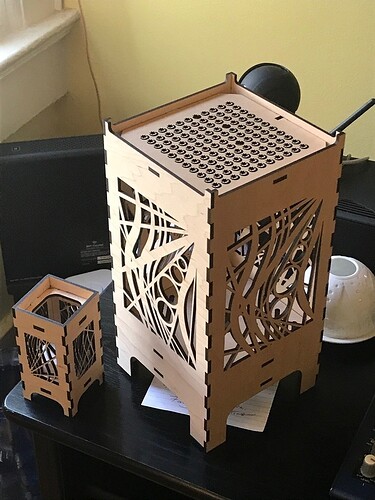So I ve had my GF a couple of weeks now and have only made a few things on my own designs.
I just wanted to share my first two designs (lamps) made on my GF.
One was a scale prototype, but its a perfect size for a votive candle holder and the other is a full size lamp. They both have different side panel cut out designs. The larger one I intend to make opaque with some handmade mulberry paper, which I have on order, and i’m working on an arduino contoller for some programmable LED lights (Neopixels) for that one
They both came out wonderfully although they taught me a couple of things in the process.
I wanted to describe my workflow as its kind of convoluted and I wanted to hear from anyone else if they have improvements. I guess most of the reason for my workflow is i’m more comfortable with Fusion 360 than Illustrator.
The main design was created in Fusion 360 parametrically modelling the box joints and general shape and created solid components for the side panels and top middle and bottom panels.
I saved this as a master file so I can make lamps of any size and cut out patters from this.
I created the side and top panel art work in Illustrator. I saved these illustrator files as SVGs
I imported the SVG art into Fusion into a copy of the master file.
I extruded cut outs based on the SVG artwork into the solid panel model in fusion for the side and top
I then saved DXF files for all the components in Fusion
It would be great to stop here and just send the DXFs to the GF
But it doesn’t support DXF files. Also my copy of Adobe Illustrator CS6 also wont import the Fusion 360 DXF
So I have to use Inkscape to open the Fusion DXF files then immediately save them as SVGs
Now the Glowforge Ap will see these and its just a case of positioning and cutting.
So that is all quite long winded… Anybody have better workflows?
I would love to see a plugin for Fusion 360 to just print out from, using the CAM side you can model a water jet or laser… but it wants to send Gcode.
I realize I could do it all in illustrator, but I cant get my head out of parametric modelling.
I also realize I don’t need a solid model of what i’m making… just the lines, so does anyone do anything just with sketches and not bodies?
Things I discovered while printing
The placement calibration is off left to right by a few mm so I cut off the edge of my wood. So one side is shorter than the other (nothing the compound miter saw wont fix) - but how do people maximize the use of the wood if you cant rely on where its going to print in relation to the scan image?
In removing the tape from the sun and moon patter, I broke a few of them as they’re fragile… how do people remove the tape on delicate items?
Thanks
Jerome



 Corner registration marks work well for regular shaped materials.
Corner registration marks work well for regular shaped materials.